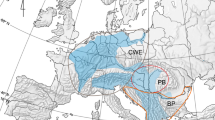Abstract
This article presents the first results of an analysis of CO1, ITSs, and 18SrRNA genes for populations of the invasive species Eurytemora velox (Lilljeborg, 1853) from the Cheboksary Reservoir and a lake in Kyiv. An analysis of the regions of the CO1 and ITSs genes showed that the studied populations differ by several nucleotide substitutions. The analysis of two DNA sequences of the conserved nuclear gene 18SrRNA as expected did not reveal the differences between the populations. A comparison of the data with sequences from the water bodies of Poland (from the GenBank https://www.ncbi.nlm.nih.gov/nuccore/MT146445) showed that they are grouped with eurytemoras from the Cheboksary Reservoir. It is likely that the E. velox found in the water bodies of Poland originates from the Caspian region, from where the eurytemora also settled in the Cheboksary Reservoir. The population from the lake in Kyiv most likely came up the Dnieper River from the Black Sea region. Thus, apparently, we are dealing with an independent dispersal of the species from at least two donor regions.

Similar content being viewed by others
REFERENCES
Borutskii, E.S., Stepanova, L.A., and Kos, M.S., Opredelitel’ Calanoida presnykh vod SSSR (Guide for Identification of Freshwater Calanoida of the USSR), Leningrad: Nauka, 1991.
DNA sequence data of Eurytemora velox. https://www.ncbi.nlm.nih.gov/nuccore/MT146445. Cited June 1, 2021.
Ekmann, S., Uber das Crustaceen plankton des Ekoln (Mälaren) und fiber verschiedene Kategorien von marinen Relikten in schwedischen Binnenseen, in Zoologiska Studier. Festskrift Wilhelm Lilljeborg Tillegnad pa Hans Attionde Födelsedag af Svenska Zoologer, Upsala: Almqvist and Wiksells, 1907.
Elton, C., The ecological relationships of certain freshwater copepods, J. Ecol., 1929, vol. 17, no. 2, p. 383. https://doi.org/10.2307/2256050
Gaviria, S. and Forro, L., Morphological characterization of new populations of the copepod Eurytemora velox (Lilljeborg, 1853) (Calanoida, Temoridae) found in Austria and Hungary, Hydrobiologia, 2000, vol. 438, p. 205. https://doi.org/10.1023/A:1004173704289
Lazareva, V.I., Long-term changes in the composition and abundance of the zooplankton community in Kama River reservoirs, Inland Water Biol., 2020, vol. 13, no. 2, p. 214. https://doi.org/10.1134/S199508292002025X
Litvinova, A.G. and Vezhnovets, V.V., Distribution and abundance of the alien calanoid copepod Eurytemora velox Lilljeborg, 1853 in the Dnieper-Bug Canal, Materialy 18-i Mezhdunarodnoi nauchnoi konferentsii “Sakharovskie chetniya 2018: Ekologicheskie problemy XXI veka,” Minsk, 17–18 maya 2018 g. (Proc. Eighteen Int. Sci. Conf. “Sakharov’s Readings-2018: Environmental Problems of 21st Century,” Minsk, May 17–18, 2018), Minsk: Inf.-Vych. Tsentr, Minist. Finans., Resp. Bel., 2018, p. 61.
Rybinskoye vodokhranilishche i ego zhizn’ (Rybinsk Reservoir and Its Life), Leningrad: Nauka, 1972.
Sabaneev, P.L., Eurytemora velox (Lill.) in the flat part of Dnieper, Zb. Pr. Dnipr. Biol. Stn., 1930, no. 5.
Samchishina, L.V., Recent introduction of an oligohaline species Eurytemora velox (Lill.) (Copepoda, Calanoida) to the Dnieper River and its large tributaries, Ekol. Morya, 2000, no. 52, p. 52.
Samchyshyna, L., Gromova, Y., and Zorina-Sakharova, K., Recent distribution of Eurytemora velox (Lilljeborg, 1853) (Copepoda, Calanoida) in brackish and fresh waters of Ukraine, Crustaceana, 2020, vol. 93, nos. 3–5, p. 275. https://doi.org/10.1163/15685403-00003992
Sars, G.O., Temorella lacinulata (Fischer), Ezheg. Zool. Muz. Imper. Akad. Nauk, 1897, vol. 2, p. 66.
Spandl, H., Copepoda. Ruderfusskrebse, P. Schulze Biol. Tiere Dtschl., 1926, vol. 15, p. 1.
Sukhikh, N.M., Souissi, A., Souissi, S., et al., Genetic and morphological heterogeneity among populations of Eurytemora affinis (Crustacea: Copepoda: Temoridae) in European waters, C.R. Biol., 2016, vol. 339, p. 197. https://doi.org/10.1016/j.crvi.2016.03.004
Travyanko, V.S. and Tseeb, Ya.Ya., Zooplankton of the upper Dnieper River and reservoirs of its floodplain, in Gidrobiologicheskii rezhim Dnepra v usloviyakh zaregulirovannogo stoka (Hydrobiological Regime of the Dnieper River in Conditions of Regulated Run-Off), Kiev: Naukova Dumka, 1967, p. 74.
Volga i ee zhizn’ (Volga River and Its Life), Leningrad: Nauka, 1978.
Winkler, G., Souissi, S., Poux, C., et al., Genetic heterogeneity among Eurytemora affinis populations in Western Europe, Mar. Biol., 2011, vol. 158, p. 1841. https://doi.org/10.1007/s00227-011-1696-5
Zernov, S.A., Plankton of the Sea of Azov, Ezheg. Zool. Muz. Imper. Akad. Nauk, 1901, vol. 6, p. 4.
ACKNOWLEDGMENTS
We thank L.V. Samchyshyna (Ukrainian Institute of Fisheries of the National Academy of Agrarian Sciences) for providing the material from the lake in Kyiv and we are grateful to an independent reviewer for their comments and advice on improving the text.
Funding
This study was carried out at the Equipment Sharing Center “Taxon” in accordance with the national research initiative of the Zoological Institute of Russian Academy of Sciences AAAA-A19-119020690091-0 “Research into the Biological Diversity and Mechanisms of the Impact of Anthropogenic and Natural Factors on the Structural and Functional Organization of Ecosystems of Continental Water Bodies. Systematization of Biodiversity of Salt Lakes and Saline Inland Seas in the Critical Salinity Zone and Study of the Role of Brackish-Aquatic Species in Ecosystems” and the Papanin Institute for Biology of Inland Waters, Russian Academy of Sciences, topic 121051100109-1 “Systematics, Diversity, Biology, and Ecology of Aquatic and Semiaquatic Invertebrates and the Structure of Populations and Communities in Continental Waters,” and supported by grants from the Russian Foundation for Basic Research no. 20-34-70020, 20-04-00035, and 19-04-00217.
Author information
Authors and Affiliations
Corresponding author
Ethics declarations
Conflict of interests. The authors declare that they have no conflicts of interest.
Statement on the welfare of animals. All applicable international, national, and/or institutional guidelines for the care and use of animals were followed.
Additional information
Translated by V. Mittova
Rights and permissions
About this article
Cite this article
Sukhikh, N.M., Lazareva, V.I. First Results of a Molecular Genetic Analysis of the European Invader Eurytemora velox (Crustacea, Calanoida). Inland Water Biol 15, 201–203 (2022). https://doi.org/10.1134/S1995082922020122
Received:
Revised:
Accepted:
Published:
Issue Date:
DOI: https://doi.org/10.1134/S1995082922020122




